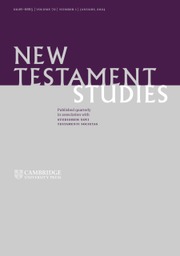 The July issue of NTS contains an interesting text-critical offering by Aļesja Lavrinoviča: ‘1 Cor 14.34–5 without ‘in All the Churches of the Saints’: External Evidence’. The abstract goes like this:
The July issue of NTS contains an interesting text-critical offering by Aļesja Lavrinoviča: ‘1 Cor 14.34–5 without ‘in All the Churches of the Saints’: External Evidence’. The abstract goes like this:The present study of the oldest and most relevant extant manuscripts that contain 1 Cor 14.33b–35 shows that v. 33b (ὡς ἐν πάσαις ταῖς ἐκκλησίαις τῶν ἁγίων) is not connected with vv. 34–5. Scribes would consider 33b to be a part of 33a. Manuscripts ℵ, A, B, Fuldensis, D, F, G, ms. 88* clearly read 1 Cor 14.34–5 as a separate paragraph. In these manuscripts, where vv. 34–5 are found after v. 40, v. 33b closely follows 33a. P46 and P123 are damaged and require reconstruction. Moreover, Greek New Testament editions that link v. 33b with v. 34 reflect exegetical decisions and are not based on external evidence.Broadly speaking, it seems that Lavrinoviča has made a plausible cumulative case, even if some of the details adduced seem problematic. For instance, Lavrinoviča mentions ‘slashes’ in P46, which she takes to be indicative of text-division, yet without citing any primary evidence or relevant secondary literature apart from Comfort’s general remarks in his Encountering Manuscripts. Here a reference to Edgar Ebojo’s recent thesis on P46 would have been useful. (By the way, the ‘slashes’ in Chester Beatty Biblical papyri are an interesting phenomenon, not exclusive to P46, and would probably repay some further specialised study.) In a similar vein, what the author does not seem to pay much attention to is that various phenomena listed as indicating text-division often appear inconsistent and sometimes downright iffy (e.g. vacant spaces can occur in the middle of a word; ekthesis occurs where you wouldn’t expect a ‘major’ break in the text’ based on the surrounding occurrences; a ‘slash’ used mid-sentence; etc).
Despite these quibbles, I enjoyed Lavrinoviča’s approach, which sits well with the recent trends in Editionswissenschaft whereby editors increasingly consider the manuscript data in deciding matters such as orthography, punctuation, and text-structuring rather than merely imposing a system of their own or standardising solely according to modern conventions. From a reception-historical standpoint, MSS data such as those adduced by Lavrinoviča can come extremely handy for exegetical purposes. Few of us would doubt that the way the text is laid out considerably impacts one’s reading. Having said that, appropriating MS evidence to such end needs a healthy dose of critical scrutiny. What does it mean in this particular case? Well, even if one followed the said MSS in dividing the text after v. 33b, that says next to nothing about the (in)authenticity of vv. 34–5. This, of course, is not the line of argument pursued (directly at least) in the article, but it is not difficult to imagine someone jumping the gun here.
"In these manuscripts, where vv. 34–5 are found after v. 40," should probably read, "In those manuscripts where vv. 34–5 are found after v. 40," as the first listed mss have them in the usual order. This misversification was a huge blunder by NA editors over the years, and also included an errant comma.
ReplyDeleteThat's a bad mistake to have in the abstract of an NTS article. I believe it is D, E, F, G, 88*, and 4th century Ambrosiaster that have 34-35 after 40.
Delete